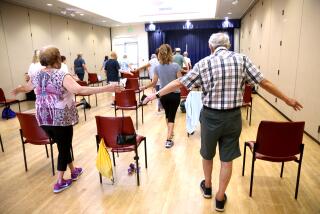$2.1 Million Committed to Study of Aging
- Share via
Aging is a hot topic these days, partly because of the burgeoning numbers of older people and partly because of the vigorous image and remarkable recovery from surgery of the nation’s No. 1 senior citizen, Ronald Reagan.
Now the John D. and Catherine T. MacArthur Foundation has committed $2.1 million for a two-year program to look into successful aging.
A research team of experts across the country--including two in Southern California--will seek to find out why some people remain youthful and vibrant despite their age while others seem to grow too old too early. The team will include researchers in neuroscience, molecular genetics, psychology, sociology and gerontology.
Research Is Late
Dr. John W. Rowe, director of the division of aging at Harvard Medical School and director of the gerontology division at Boston’s Beth Israel Hospital, will head the MacArthur Foundation study, which he said is the first of its kind.
He conceded that research is late to the subject--but said that, after all, the topic of aging is relatively new in scientific circles.
“I’m 41 and I’m considered an old man in the field. The program I run at Harvard is the largest program in geriatric medicine in the country--and it was established in 1979,” he said.
“But being late to the topic has advantages in that there has been a lot of progress recently in genetic research, especially in modern molecular techniques developed only in the past few years. We can capitalize on this.”
Identifying Genetic Markers
Rowe, who described himself as essentially a researcher “with your basic white coat and test-tube,” ventured a hypothesis about what the research program might turn up. First, he explained that it will seek to identify genetic markers and the physiological, psychological and social characteristics of successful aging.
“I suspect that we will find that there are psychosocial factors that make up for medical/genetic deficiencies,” he said. “If a person has favorable psychosocial characteristics, they will in some way make up for unfavorable genetics.”
Rowe said that there is a “tremendous variation” in the way people age, that they become less like each other, not more alike, as they age.
“We need to find measures that predict aging better than a person’s birth certificate,” he said.
He also differentiated between two predictors of aging: vitality and resilience.
“Vitality,” he said, “is a general measure of a person’s psychosocial and physical status. Vitality combines genetic, biological and psychological factors that are constantly being molded by the environment.
“Resilience is a person’s capacity to respond successfully to physical, psychological or social stresses,” a capacity that is directly proportionate to a person’s vitality.
Southern Californians who will participate in the study are Carl Cotman Ph.D., professor of psychobiology at UC Irvine and director of the Neuroscience Assn., and Caleb Finch Ph.D., professor of biological sciences and gerontology at USC’s Andrus Gerontology Center.
Cotman will study the matter of resilience, especially the capacity of the brain to repair itself after injury, say from a stroke or accident.
“We know that there is continuous repair going on in the brain,” Cotman said, “and that if a person is young and has an injury he will come back, whereas an older person often doesn’t. But there is a lot of variability between individuals.
‘Looking for a Clue’
“We will be looking for a clue as to what the normal system is using (to repair itself), and we also will be looking at the normal maintenance program and if it works harder if it is hurt.”
Finch will do research on the molecular biology of how the brain responds to stress, which can create its own injuries.
“There are mechanisms by which steroids damage the brain that so far have only been proved in rodents,” Finch said. “Under some conditions steroids of the ovary and adrenal glands can kill brain cells, can have long-term effects.
“This has enormous potential importance, especially in view of the many kinds of drugs and stresses we are all exposed to. We also think there may be natural antidotes contained in the body; progesterone may protect against damaging effects of estrogen, for instance.”
The three researchers, each interviewed by phone, concurred on the key factor in the study: to learn about successful aging as opposed to the many studies of the pathology of aging.
“If we can learn how to predict the elements of vitality and resilience that are characteristic of successful aging, we may be able to modify some of the aspects of people’s lives that work against successful aging,” Rowe said. “The fact that there is so much variability among aging people suggests that aging is modifiable.”
Endowing the Program
Dr. John E. Corbally, president of the MacArthur Foundation, said that it is endowing the program for four main reasons:
--Aging will be the No. 1 health problem in the nation over the next few decades. Presently people 65 and older make up 11% of the population but account for 29% of health-care costs.
--The study of aging currently lacks a strong academic base because it has not been included fully in traditional academic medicine.
--Recent developments in molecular genetics and neurobiology may make possible breakthroughs in knowledge about the aging process.
--Present research on aging focuses on the losses people experience as they grow older and on specific diseases of aging, and this research may exaggerate the significance of chronological age, rather than other factors, in predicting losses of function with age.
Researchers at the following institutions also will take part in the study:
Massachusetts General Hospital, Yale University, Foundation for Child Development (New York City), Duke University, University of Wisconsin-Madison, University of Minnesota, University of Michigan, Pennsylvania State University, Johns Hopkins Hospital, VA Medical Center (Bronx, N.Y.) and the National Institute on Aging.






